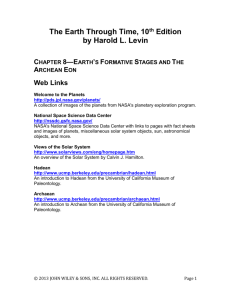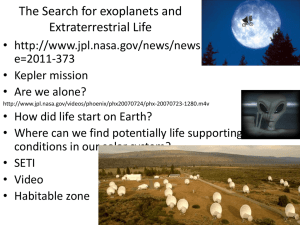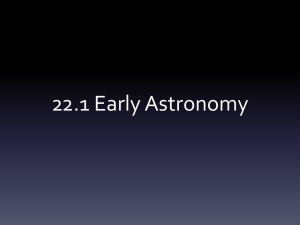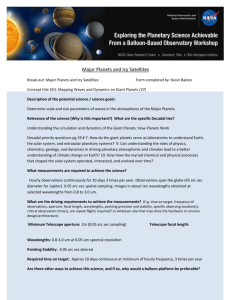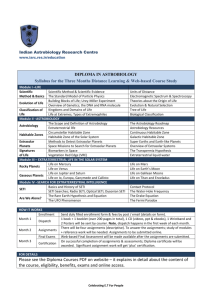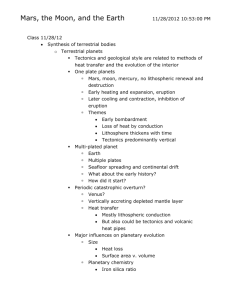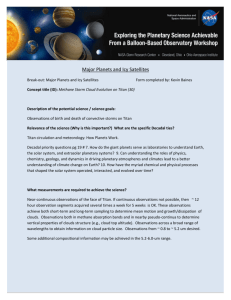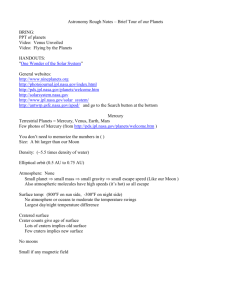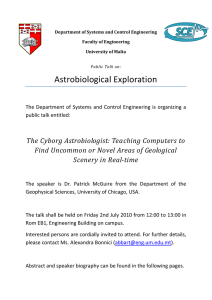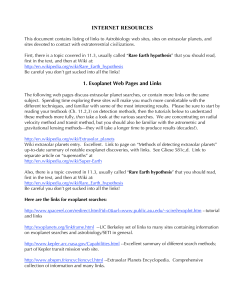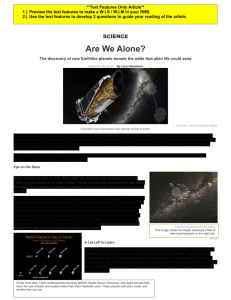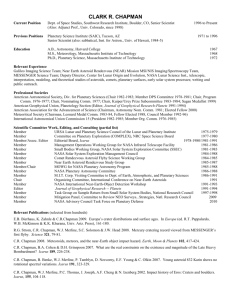Exoplanet and Astrobiology Webquest Go to each of the URLs
advertisement
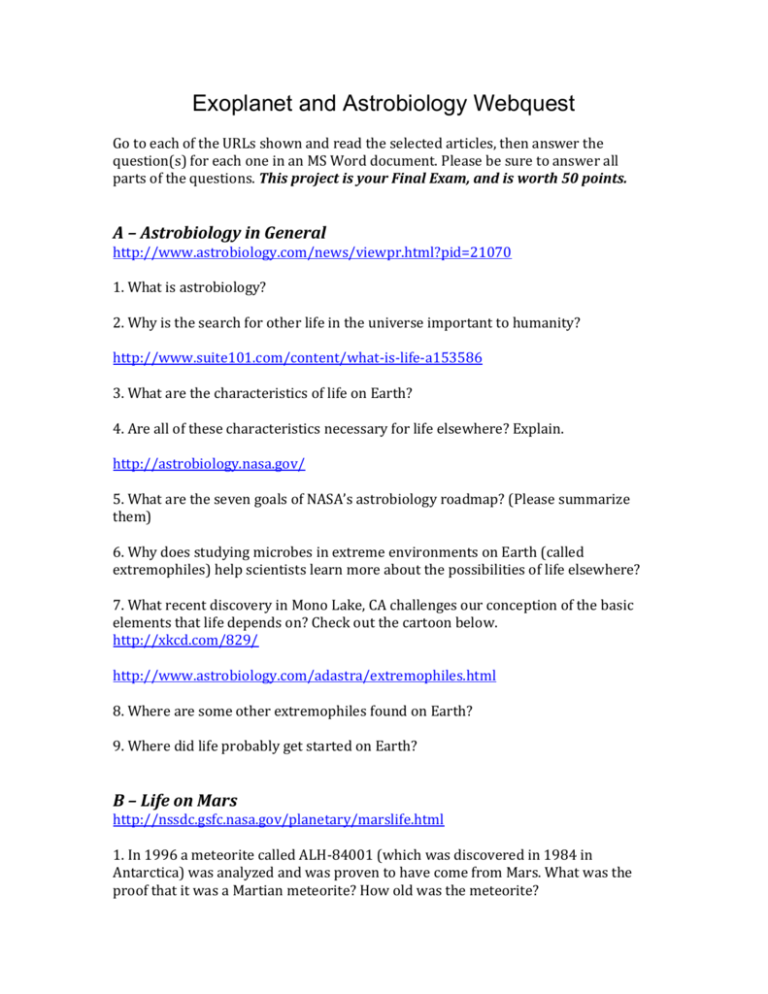
Exoplanet and Astrobiology Webquest Go to each of the URLs shown and read the selected articles, then answer the question(s) for each one in an MS Word document. Please be sure to answer all parts of the questions. This project is your Final Exam, and is worth 50 points. A – Astrobiology in General http://www.astrobiology.com/news/viewpr.html?pid=21070 1. What is astrobiology? 2. Why is the search for other life in the universe important to humanity? http://www.suite101.com/content/what-is-life-a153586 3. What are the characteristics of life on Earth? 4. Are all of these characteristics necessary for life elsewhere? Explain. http://astrobiology.nasa.gov/ 5. What are the seven goals of NASA’s astrobiology roadmap? (Please summarize them) 6. Why does studying microbes in extreme environments on Earth (called extremophiles) help scientists learn more about the possibilities of life elsewhere? 7. What recent discovery in Mono Lake, CA challenges our conception of the basic elements that life depends on? Check out the cartoon below. http://xkcd.com/829/ http://www.astrobiology.com/adastra/extremophiles.html 8. Where are some other extremophiles found on Earth? 9. Where did life probably get started on Earth? B – Life on Mars http://nssdc.gsfc.nasa.gov/planetary/marslife.html 1. In 1996 a meteorite called ALH-84001 (which was discovered in 1984 in Antarctica) was analyzed and was proven to have come from Mars. What was the proof that it was a Martian meteorite? How old was the meteorite? 2. What evidence was found that supported the possibility of ancient life on Mars? http://www.nasa.gov/mission_pages/mars/news/marsmethane.html 3. Why shouldn’t there be methane in Mars’ atmosphere? 4. What could be the possible sources of this methane? 5. Why does this increase the probability that Mars once had (or still has) life? C – Life Elsewhere in Our Solar System http://discovermagazine.com/videos/27-life-on-europa 1. Why do scientists think there could be life on Jupiter’s moon, Europa? 2. What would we have to do to detect that life? http://www.time.com/time/health/article/0,8599,1995828,00.html 3. What evidence is there that there could be life on Saturn’s moon, Titan? 4. Why are scientists and NASA very cautious about making such announcements? http://www.sciencedaily.com/releases/2009/04/090428144126.htm 5. Where did the elements for life come from on Earth? 6. How widely are these elements distributed throughout the solar system? D – Extra-solar Planets (Exoplanets) http://www.esa.int/esaSC/SEMYZF9YFDD_index_0.html 1. What are the methods that can be used to detect a planet orbiting another star (an exoplanet)? 2. What method has been used the most up until now? Why? http://www.planetary.org/exoplanets/list.php 3. Scientists have now discovered over 500 exoplanets. Looking at the list, what are the most common sizes we have discovered so far? 4. Describe the orbits of the majority of the planets found (e.g., are they close or far from their star? Are they highly eccentric (elliptical)? What are their orbital periods?) 5. Do our results indicate that planetary systems like our solar system are rare or are our methods so far inadequate? Explain. 6. What planetary systems discovered so far are most like our solar system? http://kepler.nasa.gov/ http://www.sciencedaily.com/releases/2010/08/100826142952.htm 7. What area of the sky is the Kepler probe looking at? Why was this area chosen? 8. Describe the method that Kepler is using to discover extra-solar planets. 9. What results has Kepler announced so far? Why do we think Kepler will be able to detect Earth-sized planets? http://www.sciencedaily.com/releases/2008/03/080307121613.htm 10. What are the possibilities that Alpha Centauri could have Earth-like planets? 11. What other stars near us (within 12.5 light years) are likely to have planets? http://www.sciencedaily.com/releases/2010/12/101208172320.htm 12. How is it possible to actually photograph planets outside our solar system? 13. What is unusual or unexpected about this planetary system? E – Life in Other Planetary Systems http://science.nasa.gov/science-news/science-at-nasa/2003/02oct_goldilocks/ 1. What is the “Goldilocks Zone” and why is it larger than we once thought? http://news.yahoo.com/s/ap/20100929/ap_on_sc/us_sci_new_earths 2. What recent discovery is getting astrobiologists excited? What is the parent star (Gliese 581) like? 3. What conditions on this planet would make life likely? Unlikely? http://www.sciencedaily.com/releases/2009/03/090320131521.htm 4. How will the James Webb Space Telescope be used to determine if Earth-sized planets have the biomarkers of life in their atmospheres? http://planetquest.jpl.nasa.gov/TPF/tpf_index.cfm 5. What is the Terrestrial Planet Finder? Describe the two main components and how they will work. 6. Why is the question of life outside Earth likely to be answered positively in the next 50 years (that’s within your own lifetime)? F – SETI and Interstellar Travel http://www.seti.org/drakeequation 1. What is the Drake Equation and what do each of its terms mean? 2. What was Project Ozma, and what did it find? 3. What other SETI projects have been attempted, with what results? What projects are occurring now and what projects are planned? 4. Why is the 21 cm radio band used for listening to possible alien signals? http://news.discovery.com/space/a-mathematical-twist-on-the-fermi-paradox.html 5. What is the Fermi Paradox? 6. What is the most likely solution to (or reason for) this paradox? 7. In your opinion, would meeting an extraterrestrial intelligence be a good thing or a bad thing for humanity? Why? http://www.tauzero.aero/index.html 8. What was Project Daedelus? 9. Describe the designs of the following proposed interstellar propulsion systems and explain how each would work: Orion, Bussard ramjet, solar sails, laser sails 10. What is the purpose of the Tau Zero Foundation and do you think they will ever achieve their goal?


